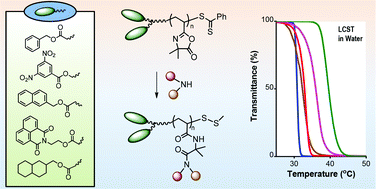RAFT-prepared α-difunctional poly(2-vinyl-4,4-dimethylazlactone)s and their derivatives: synthesis and effect of end-groups on aqueous inverse temperature solubility†
Abstract
A series of five novel R-group di-functional phenyl dithiobenzoates have been prepared and utilized in the controlled reversible addition–fragmentation chain transfer (RAFT) radical polymerization of 2-vinyl-4,4-dimethylazlactone (VDMA), yielding a series of homopolymers of similar average degrees of polymerization but variable α-end group functionality. Each of the reactive polyVDMA homopolymers was reacted with four different small molecule amines: dimethylamine, diethylamine, N,N-diethylethylenediamine and tetrahydrofurfurylamine yielding a series of novel end-functional materials. The effect of the end-groups on the inverse temperature dependent aqueous solubility of the formally hydrophilic homopolymers was then measured and compared to similar materials prepared with benzylpropyltrithiocarbonate as the RAFT agent. In virtually all instances, the introduction of the twin α-end-groups resulted in overall more hydrophobic species that exhibited cloud points spanning the range 25.1–42.7 °C. Importantly, there was a strong influence on the nature of the end groups and the associated solubility characteristics with, in some cases, cloud point behaviour only being observed in polymers with twin end groups while those derived from benzylpropyltrithiocarbonate were fully soluble.

- This article is part of the themed collection: Celebrating The Five-Year Anniversary of Polymer Chemistry

 Please wait while we load your content...
Please wait while we load your content...